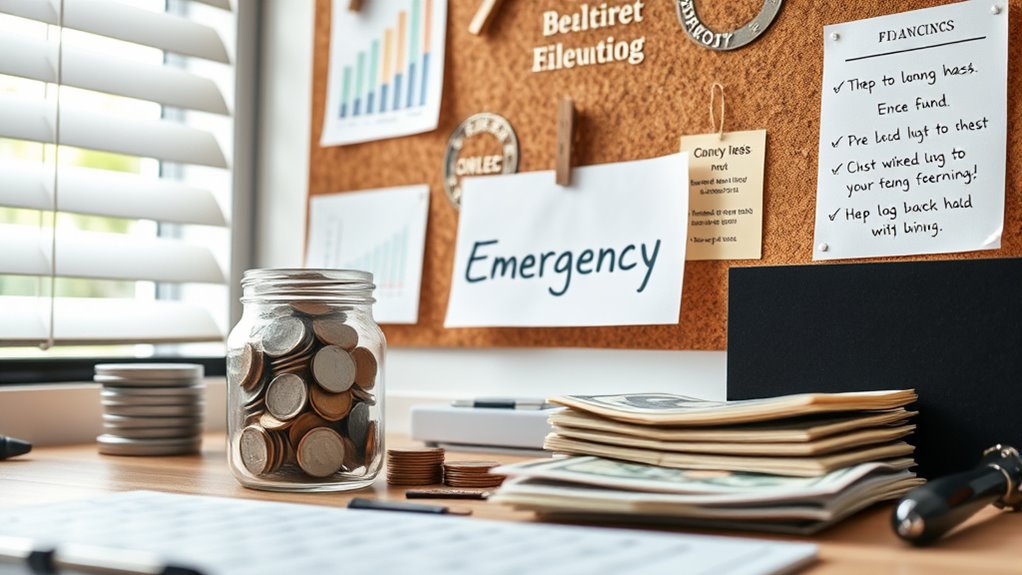Building an emergency fund is essential because it acts as a safety net during unexpected events like job loss or medical emergencies. To start, save a small amount regularly, aiming for three to six months’ worth of expenses. Keep the fund in a liquid account and avoid using it for non-emergencies. Staying disciplined and consistent helps grow your cushion, so you’re prepared for life’s surprises. Continue to explore ways to build and maintain your emergency fund effectively.
Key Takeaways
- An emergency fund provides a financial safety net during unexpected events like job loss or health issues.
- Building a fund starts with saving a small amount, such as $1,000, and gradually increasing it over time.
- Aim to save enough to cover 3 to 6 months of living expenses to ensure sufficient protection.
- Keep the emergency fund in liquid, separate accounts to ensure quick access during emergencies.
- Regularly review and replenish the fund after use to maintain financial security and peace of mind.

Building an emergency fund is one of the most important steps toward financial stability. It acts as a safety net during unexpected events like job loss, illness, or major expenses. Having this financial cushion means you won’t have to rely on high-interest debt or scramble for funds when life throws you a curveball. Instead, you’ll gain peace of mind, knowing you’re prepared for the unforeseen. An emergency fund also helps reduce stress and anxiety, allowing you to face uncertainties with confidence. When you’re not worried about covering basic expenses during tough times, you can focus on more important things, like planning for the future or maintaining your health.
Building an emergency fund provides peace of mind and a safety net during unexpected life events.
One of the key benefits of an emergency fund is avoiding the need to borrow money at high interest rates or dip into retirement savings prematurely. Borrowing can lead to long-term financial setbacks, making it harder to reach your goals. By setting aside a dedicated amount regularly, you create a safety buffer that keeps you from falling into debt when emergencies happen. Plus, a sizable fund becomes even more critical in retirement, where there’s no steady paycheck, and expenses can unexpectedly increase. A larger emergency fund ensures you can cover several months of living costs, providing extra security during retirement years.
Having an emergency fund also boosts your overall financial well-being. Studies show that people with at least $2,000 saved experience higher levels of financial satisfaction. It prepares you for unexpected costs like car repairs or home maintenance, which can otherwise derail your budget. The psychological benefits are significant—less worry, less stress, and a greater sense of control over your finances. In the long run, an emergency fund supports your financial health by acting as a cushion against shocks and helping you stay on track with your broader financial goals. Developing a solid understanding of your financial terms and jargon can help you make informed decisions about your savings and investments.
Getting started might seem intimidating, but even small steps make a difference. Begin with a modest goal, such as saving $1,000 or $2,000. This initial target builds momentum and gives you a sense of accomplishment. Commit to saving a portion of your income each month and consider automating transfers to your savings account to make it easier. Aim to accumulate enough to cover three to six months of expenses, depending on your circumstances. For retirees, more coverage is advisable. Having a dedicated savings account increases your chances of maintaining your fund because it keeps your emergency savings separate from everyday spending money.
Maintaining your emergency fund requires regular review and adjustment. As your expenses or income change, update your savings goals accordingly. Keep the fund in liquid assets so you can access it easily when needed. Avoid dipping into it for non-emergencies, and if you do use it, prioritize replenishing it quickly afterward. Building and sustaining an emergency fund demands discipline and a long-term commitment, but the peace of mind it offers makes it well worth the effort. When you have a solid emergency fund, you’re better equipped to handle life’s surprises without derailment, ensuring your financial stability now and in the future. Building an emergency fund also requires understanding the approximate size needed to cover unexpected expenses, which typically ranges from three to six months of your total expenses.]
Frequently Asked Questions
How Much Should I Initially Save for My Emergency Fund?
You should start by saving enough to cover three to six months of essential expenses. Focus on what you need for essentials like rent, groceries, and utilities. If you’re just beginning, aim for at least one month’s worth of expenses. Make consistent contributions, even small ones, and gradually build your fund. This approach helps protect you against unexpected financial setbacks and provides peace of mind.
Can I Use My Emergency Fund for Non-Emergency Expenses?
You should avoid using your emergency fund for non-emergency expenses because it’s meant to cover unexpected events like medical bills, car repairs, or job loss. If you dip into it for regular expenses, you risk being unprepared when a true emergency occurs. Keep your fund untouched for genuine emergencies, and replenish it as soon as possible if you need to use it, ensuring you’re always ready for unexpected financial setbacks.
How Often Should I Review and Adjust My Emergency Fund?
You should review and adjust your emergency fund at least once a year, or whenever your financial situation changes substantially. Regularly checking helps guarantee you have enough saved for unexpected expenses. If your income increases or your expenses grow, add more to your fund. Conversely, if your financial priorities shift, reassess and adjust your savings goals. Staying proactive keeps your emergency fund reliable and ready when needed.
Are There Best Places to Keep My Emergency Savings?
You should keep your emergency savings in a high-yield savings account or a money market account. These options offer easy access when you need funds quickly, and they typically provide better interest rates than regular savings accounts. Avoid keeping your emergency money in stocks or long-term investments, as those can be hard to access during a crisis. Prioritize safety, liquidity, and a decent return when choosing where to store your emergency fund.
What Are Common Mistakes to Avoid When Building an Emergency Fund?
Think of your emergency fund as a safety net—don’t let it fray. Avoid common pitfalls like dipping into it for non-emergencies or neglecting to contribute regularly. Don’t overlook setting realistic goals or keeping funds in inaccessible accounts that discourage saving. Also, resist the urge to invest this money in risky assets, as your goal is quick access, not growth. Stay disciplined, and your safety net will catch you when needed.
Conclusion
Think of your emergency fund as a sturdy lighthouse guiding you through stormy seas. When unexpected waves hit—car repairs, medical bills—you’ll have a bright beacon of security to rely on. Building this fund isn’t just saving money; it’s planting a lighthouse on your financial horizon. With each contribution, you illuminate your path forward, ensuring that no matter how dark the night, you’ll always find your way back to calm and safety.








